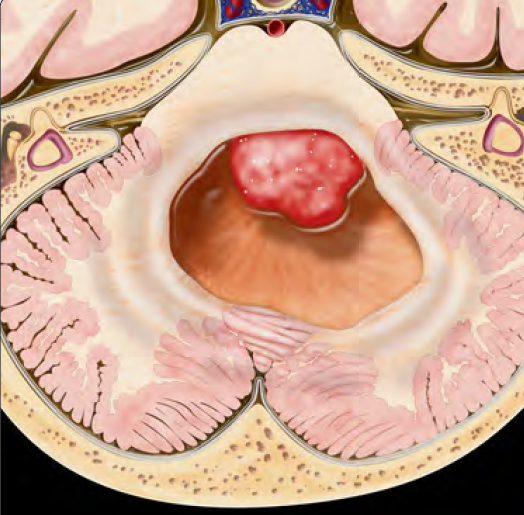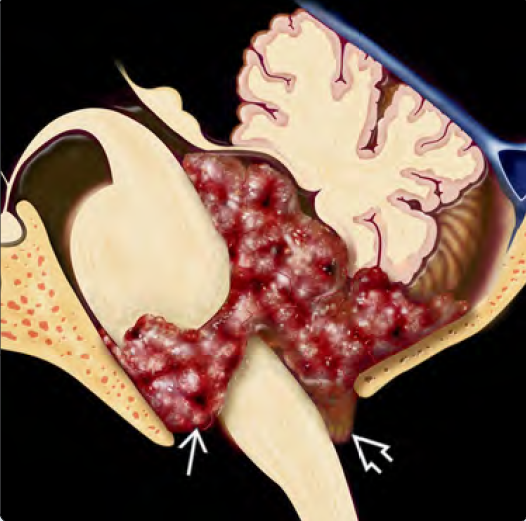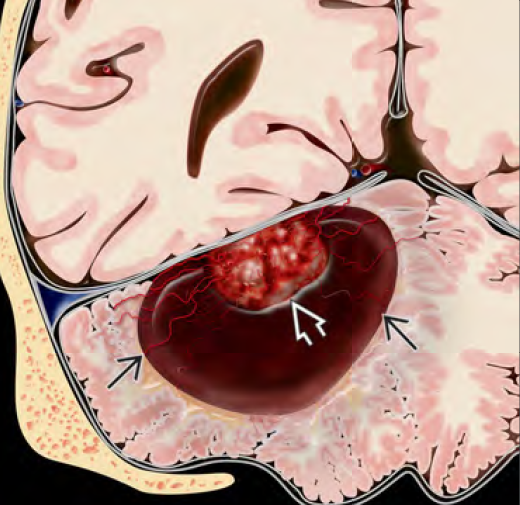Brainstem Glioma
Brainstem Glioma
Brainstem gliomas are a group of central nervous system (CNS) tumors that arise from the glial (supporting) cells within the brainstem—a vital structure responsible for regulating breathing, heart rate, swallowing, and motor coordination. These tumors can be diffuse or focal, with Diffuse Intrinsic Pontine Glioma (DIPG) being the most aggressive and challenging subtype. Brainstem gliomas account for approximately 10–20% of pediatric brain tumors, typically occurring between the ages of 5 and 10 years. Early diagnosis and a strategic multidisciplinary approach are critical, especially in Bangladesh where delayed presentation is common. 🌍 Brainstem Glioma in Bangladesh Perspective In Bangladesh, pediatric brainstem gliomas often go undiagnosed or misdiagnosed due to lack of awareness, inaccessibility to MRI, and the absence of specialized pediatric neurosurgery centers in many regions. Children presenting with facial weakness, imbalance, or eye movement abnormalities are often treated for ENT or vision issues, delaying proper neurological referral. Dr. Md. Nafaur Rahman, a leading pediatric neurosurgeon in Bangladesh, offers expert diagnosis, imaging guidance, and surgical or supportive management of brainstem tumors at the National Institute of Neurosciences & Hospital (NINS) and through the Bangladesh Paediatric Neurocare Centre, ensuring optimal care for affected children. 🧬 Types and Classification Brainstem gliomas can be categorized into: Diffuse Intrinsic Pontine Glioma (DIPG) – aggressive, non-resectable, poor prognosis Focal Brainstem Glioma – localized, potentially resectable, better prognosis Tectal Glioma – slow-growing, often managed conservatively Exophytic Medullary Glioma – arising from medulla, sometimes resectable 🧒 Common Symptoms in Children Depending on tumor type and location within the brainstem (midbrain, pons, medulla), symptoms may include: Unsteady gait (ataxia) Double vision (diplopia) or squint Facial asymmetry or drooping (cranial nerve palsies) Swallowing difficulty or hoarseness of voice Headache and early morning vomiting Behavioral changes, irritability Hydrocephalus (due to obstruction of cerebrospinal fluid pathways) Seizures (less common) In Bangladesh, these symptoms are frequently mistaken for ENT infections, sinusitis, or psychological issues, leading to harmful delays in seeking MRI and neurosurgical evaluation. 🔍 Diagnostic Workup 🧠 MRI Brain with Contrast The most accurate tool for detecting and characterizing brainstem gliomas DIPG shows a diffuse, non-enhancing lesion in the pons Focal tumors may appear as well-defined, enhancing masses with cystic components MRI of spine may be needed to check for dissemination in certain subtypes 🔬 Biopsy (Selective cases) Not routinely performed in DIPG due to risk and established radiological diagnosis Stereotactic biopsy may be considered in atypical or focal lesions 🛠️ Treatment Options Treatment depends on the type, location, and clinical presentation: 1. Diffuse Intrinsic Pontine Glioma (DIPG) Surgical removal not possible due to location and diffuse nature Radiotherapy is the mainstay (temporary symptom relief) Clinical trials and targeted therapies under research Average survival ~9–12 months despite best efforts 2. Focal Brainstem Gliomas Surgical resection possible in well-circumscribed tumors Dr. Nafaur Rahman uses microsurgical techniques, intraoperative neuromonitoring, and neuro-navigation to safely excise tumors Post-op radiation or chemotherapy considered if resection is incomplete 3. Tectal Gliomas Often managed conservatively if asymptomatic May require endoscopic third ventriculostomy (ETV) if causing hydrocephalus 🔄 Prognosis DIPG: Poor prognosis, median survival less than 1 year Focal Gliomas: Excellent prognosis with complete resection Tectal Gliomas: Slow-growing, long-term survival possible Regular MRI follow-up, physical therapy, and speech/swallow therapy are crucial ⚠️ Risks of Delayed Treatment Brainstem compression, leading to breathing difficulty and cardiac instability Permanent cranial nerve palsies (facial paralysis, vision loss) Dysphagia and aspiration pneumonia Death due to brain herniation or tumor progression 👨⚕️ Why Dr. Md. Nafaur Rahman? Bangladesh’s foremost expert in complex pediatric brain tumors Performs safe, minimally invasive neurosurgery even in delicate brainstem locations Works with a multidisciplinary team for oncological and supportive care Operates at NINS, Bangladesh’s leading center for neurosurgery Offers long-term follow-up at Bangladesh Paediatric Neurocare Centre 📞 Schedule Your Consultation Today Dr. Md. Nafaur Rahman Assistant Professor, Pediatric Neurosurgery, National Institute of Neurosciences & Hospital (NINS) Chief Consultant, Bangladesh Paediatric Neurocare Centre 📞 Serial/Consultation: 01912988182 | 01607033535 🌐 Website: www.neurosurgeonnafaur.com





